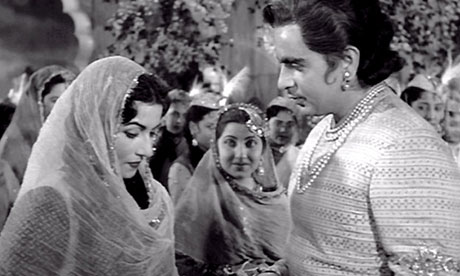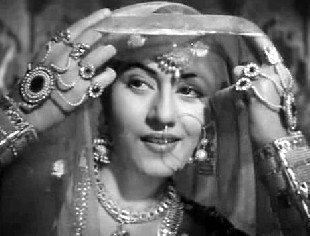Shopping for Bollywood films is both science and art form. Rare is
the film you can walk to Walmart or Target or other major store and buy on DVD
(3 Idiots is perhaps the one exception). There are Indian groceries that carry
a motley mix of pirated and legitimate, but mostly pirated. If you are very,
very lucky, there is perhaps an Indian DVD store. But their selection is never
expansive, nor guaranteed, and seeking a particular title is often an exercise in
futility.
There are libraries, but their duties are first to books and then
to DVDs and VHS. I have made some great finds at libraries, but there too it is
useless to hunt for a specific title.
The new releases quickly show up streaming on Netflix and
Einthusan, but the older titles are often hard to find online, especially if
you require subtitles.
There are sites like Induna and ErosEntertainment.com to buy DVDs,
and almost everything is on Amazon these days. But there is little to no thrill
in that. It’s akin to those who complain about buying books on Amazon rather
than in a bookstore, only worse. Not only can you not feel the DVD, it feels as
though you haven’t given it the treatment necessary for such a rarity. You
haven’t searched for the treasure. You’ve merely picked it up and methodically
paid.
.
And so sometimes, the hunt for a particular title goes on, and on,
and on, and on.
For this reason, I still haven’t seen Sholay. Or Mother
India. Or Pakeezah. Or Anand. Or a half-dozen other things.
.
But for one classic, at least, my hunting has ended.
 After two years of turning over DVDs in shops with hope, I finally
found Mughal-E-Azam at a sort of truck stop in middle-of-nowhere in
Rajasthan while busing from Jaipur to Delhi. This was the only DVD I bought in
my time in India, but if there was one to buy, I’m glad it was that.
After two years of turning over DVDs in shops with hope, I finally
found Mughal-E-Azam at a sort of truck stop in middle-of-nowhere in
Rajasthan while busing from Jaipur to Delhi. This was the only DVD I bought in
my time in India, but if there was one to buy, I’m glad it was that.
A period piece. A love story born of legend. Mughal history mixed
with said legend. Dilip Kumar, Madhubala, Prithviraj Kapoor. I had a very great
desire to see Mughal-E-Azam for many reasons. Two years of searching only made
it stronger.
.
The same for the elation I felt when I found it on my last day in
India, tucked among OMG and Student of the Year, which I spotted
first.
But even though the long wait to find Mughal-E-Azam was over, the
wait to watch it was not. Between uncharged laptops over 18 total hours of
flying and more than 18 hours of ensuing jetlag, it took me almost another week
to actually watch the film. (And even longer, you know, to write this post.)
.
But after two years, what was a few more days?
.
In a way I wondered, did the wait build an insurmountable
expectation for the film? But now I don’t think I even knew quite what I was
expecting. I knew vaguely the story of Anarkali and Salim, the court dancer and
the prince, because you can’t be around Indian culture without being exposed to
it in some form (even if it’s “Anarkali Disco Chali”). And I knew the film was
something of a revered classic.
I can understand why. Mughal-E-Azam is grand, as all things Mughal
must be (trust me: I’ve just come home from days spent in Mughalarchitecture), from sets to costumes to dialogues — all contributing to a beautiful film despite the questionable colorization. It is packed with legendary
performances and marvelous songs. And full of long dramatic scenes, such as
when Salim ascends to his place of execution for a solid five minutes while the
sculptor sings, “Zindabad! Zindabad! Mohabbat ae zindabad!” (“Long live,
long live, long live love.”)
And it has all the tenets of a great Indian story: forbidden love,
class differences, two doting mothers, family issues, the threat of
death, separation angst, an invocation of justice, a beautiful woman who could
be construed as a prostitute figure (with a heart of gold), sweeping statements
about the magnificence of Hindustan.
 |
| Dilipji's soft smiles are enough to melt the heart. |
All it lacks is a happy ending (and even its ending is not so
unhappy as it might have been).
Mughal-E-Azam is instead a very cyclical story of repeatedly
self-sacrificing love.
Salim sacrifices his rights as prince and prepares to sacrifice
his life for Anarkali. Anarkali sacrifices her freedom for Salim — refusing to
even lie about their love to save herself — and ultimately is the one who
sacrifices her life (though she is spared at the last moment from entombment,
she must live in banishment and seems mostly unresponsive). Unlike the many
Bollywood love stories since, the obstacles to love in Mughal-E-Azam are
insurmountable, due to the unflinching power and stubborn will of Akbar — the Mughal so great he was known as Akbar-e-Azam, Great the Great.
 |
| Akbar-e-Azam, Great the Great, is the real star. |
It would make an interesting contrast to watch Jodhaa Akbar and
Mughal-E-Azam back to back — reconciling Hrithik Roshan’s softened, in-love
Akbar with Prithviraj Kapoor’s resolute, heartless Akbar. (Jodhaa seems to have
less of a contrast since her love for Akbar is unwavering; Aishwarya Rai’s
Jodhaa simply has more youthful sass than Durga Khote’s, which is rather
understandable.)
 |
| Father and son's one soft moment. |
Honestly, one of the great triumphs of Prithviraj Kapoor’s Akbar
is that he isn’t hateable, even when his actions are thoroughly loathsome. Who
wants to like a man who’s so concerned with imperial honor that he condemns his
own son to death? Nobody, of course. Except maybe some sadists. Yet, as
revealed in scenes like the tremor in his hands when he sends Anarkali to her
last night with Salim, Akbar isn’t the villain of the film. He’s just the
emperor, the rule-enforcer, the man-in-charge. The true Mughal. “I swear by
Allah I am not an enemy of love,” he tells Anarkali in the end, “but a slave of
principles.”
In a way, Salim seems to have inherited the same stubbornness,
though it is directed differently. Who else but a stubborn Mughal fights a war
he knows he’ll lose against an emperor, all in the name of a dancing girl?
Anyone else would have just taken the girl and run.
Anarkali, for her part, is equally stubborn. (Maybe all of the
stubborn people in this story really just deserve one another.) Who but one of
the world’s most obstinate people could remain still when an arrow was shot at
her? And when given a way out of imprisonment for loving above her station, Anarkali doesn’t just say “no thanks.” She
instead flaunts her feelings for Salim in front of Akbar … and everyone else.
 But of course Madhubala carries it off with grace, cheek and
flair. Like every song and dance she does in the film. Full of emotions.
But of course Madhubala carries it off with grace, cheek and
flair. Like every song and dance she does in the film. Full of emotions. The same goes for all that Dilip Kumar radiates in both Salim’s
wordless looks of love and very verbal displays of defiance. The scene in which
he stumbles about drugged while realizing that he is losing Anarkali broke my
heart (while invoking shades of drunken Devdas-style desperation).
The same goes for all that Dilip Kumar radiates in both Salim’s
wordless looks of love and very verbal displays of defiance. The scene in which
he stumbles about drugged while realizing that he is losing Anarkali broke my
heart (while invoking shades of drunken Devdas-style desperation).
It certainly doesn’t hurt that Dilip Kumar is remarkably handsome
(because of or despite his perfectly coifed wig? All I can say Mughal-E-Azam is
the most attractive I’ve ever found him) and Madhubala legendarily beautiful.
Or, perhaps, that Mughal-E-Azam is an angst and hurt-filled love
story fueled by Dilip Kumar and Madhubala’s own heartbreakingly thwarted love
story. Both are stories of love versus principle in which principle ultimately
wins.
And so, in the end, the story leaves you with many emotions and
quite a bit of awe.
It’s only fitting, in a way, that Mughal-E-Azam was a film I had
difficulty finding. Nothing about the film seems to have come easy. It took
some 15 years from concept to completed project, nine of those years coming
after principal photography. Madhubala, already suffering from the heart defect that eventually killed her, fainted on set. Prithviraj Kapoor and
Dilip Kumar also suffered physically from carrying around full armor in high heat.
And, of course, Dilip Kumar and Madhubala broke up somewhere in the middle of
all that.
But some things are worth the wait and worth the suffering.



It's always heart warming to see someone appreciate a work of art like you have done here.
ReplyDeleteYou rightly noted that Akbar-e-Azam is the star here. If you have him as the founding father, if you will, of your khandan, it's no wonder that talent still lives in the fourth generation. But all said and done the original Kapoor was the only one with enough gravity to make things revolve around him just by being there. This movie needed him to balance the hot and steaming pairing of Dilip Kumar and Madhubala.
Hey, I do want to add one more thing to all that you said about the movie. The dialogues. Urdu is a language that naturally lends itself to beautiful phrases. And the dialogues were done by the eminent writers and the poets of the day. The dialogues are as much a star of the movie as anyone else. So much so that, though getting rarer now, you still can have some of the dialogues come up in a conversation among kids in small town India. And though these kids probably would know the name of the movie but certainly not the starts in it. The dialogues were the part of local lexicon when I was growing up. And I am not too old too.
Do look them up. I am not sure the subtitles would have done any justice to them.
If Akbar-e-Azam wasn't the star, they wouldn't have named the movie Mughal-e-Azam. :) And I'm a fan of Kapoors in every generation, but it is true that none of them quite have the gravitas of the original.
DeleteMy Hindi-Urdu comprehension level is still not what I'd like it to be, but I will say that the subtitles on Mughal-e-Azam were much better at keeping the poetics than other classic films I've watched. (For example, the subtitles when I tried to watch Pyaasa were a disaster.) I'm sure they still don't do the dialogues justice, but then neither does my rudimentary comprehension. Haha.
Hello sir
ReplyDeleteNice blog And Info Also Good That you can provide
Sir please update the latest page Info About Dilip Kumar Dialogues i want to need latest info for my School project ...